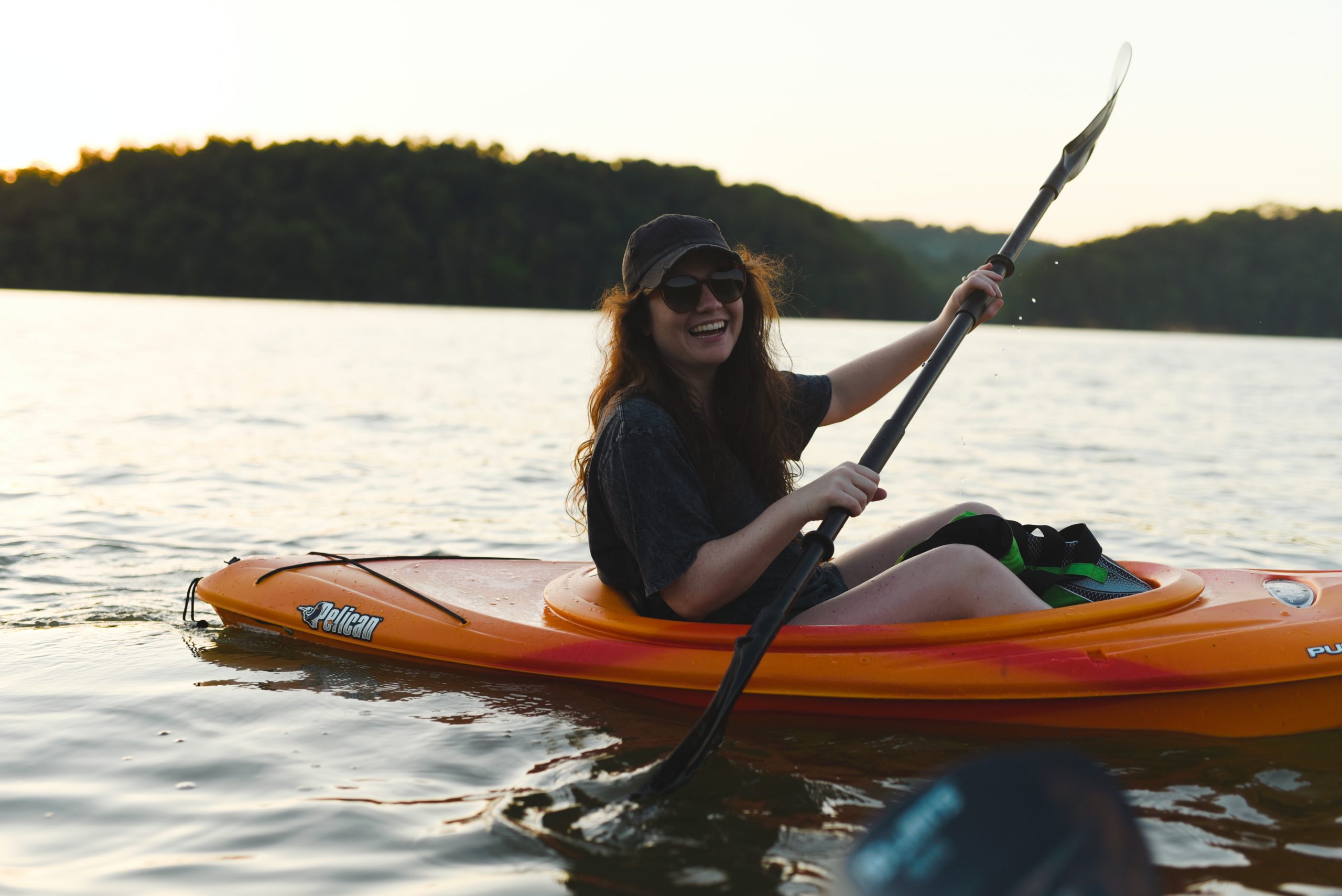In this article I’ll share with you some ideas to enhance your self awareness and some steps to help you sit more comfortably and improve your performance in athletic and recreational activities that involve seated positions.
My own experience of injury and chronic back pain resulted in my inability to participate in the adventuresome athletic activities I’d built my life around. My determination to reclaim my life led me to become a Feldenkrais® Practitioner, an ergonomic consultant and to develop and lead Feldenkrais Retreats and Eco-Adventures throughout the world to help others develop their skills and regain the confidence to fully participate in life!
The field of ergonomics focuses on providing an environment that facilitates “neutral posture” in order to reduce strain, repetitive stress, pain and injury.
The Feldenkrais Method® offers brilliant strategies to effortlessly improve your skills, abilities and awareness in using your entire body to help you move and feel better, resolve and/or avoid strain, repetitive stress, pain and injury.
Think for a moment about how you feel when you do an activity in a seated position. Do you feel vibrant, alive and energized? Or do you sometimes feel as though it takes a lot of effort to sit up, or perhaps you start to feel tense, tired, stiff or uncomfortable? Maybe you catch yourself slumping while you’re sitting or collapse into the back of the chair, so you don’t have to strain or tighten muscles to hold yourself up.
Let’s begin to explore some gentle movement possibilities in concert with basic ergonomic principles, to cultivate and enhance your learning, awareness, comfort and performance.
Try this little experiment: Sit upright on your sitting bones to the best of your ability. Now relax completely as though you were falling asleep. Just observe what happens when you do this. Are you still sitting upright? Do you rock back and collapse into a slumped position? Do you tip forward or to the side? Does your lower spine stay supported – yet you collapse in the chest, upper back or neck?
It is possible to do this experiment, and find that your spine can remain upright without using any effort! This will not be a matter of stretching, strengthening or tensing muscles. Instead, it’s quite possible to access support from your own skeleton to remain upright even when you relax completely! By stimulating the natural intelligence of your body through gentle movements and mindful attention to your movement and sensation, the brilliance of your own nervous system can learn to develop and integrate this effortless uprightness to improve your function and comfort over time.
The other benefit to supporting your uprightness skeletally, is that it also allows you to effortlessly mobilize your spine to generate your most efficient and effective source of power for reaching, twisting and performing tasks with your upper body. Whereas, if your muscles are busy holding you up, they are already short and tight and are not available to do anything else. Similarly, if you settle into a slumped position. The bones of the spine itself are more or less “locked” in place and are not available to provide movement.
Try the falling asleep experiment again and this time, after you’ve settled into your “relaxed” position, gently reach around yourself or replicate kayak paddling movements. See if you can notice how many parts of your spine and trunk are available to help you do this, vs. how many vertebrae feel “locked up” or are unavailable. This lack of free spinal movement forces you to work harder in activities you need or want to do, from simple everyday reaching and turning to more playful recreational activities like paddling a kayak.
Another, often overlooked, source of support for sitting is the “tripod” of both feet and legs along with the sitting bones of your pelvis. This creates far more stability and support for uprightness than just using your pelvis. We’ll explore this a bit in the scenario below, sitting in a chair.
Sitting is most comfortable and functional when movement is possible. When your hip joints are open they create space for the top of the pelvis to be tilted slightly forward. This allows your sitting bones to come into a position to provide you with a solid base of support.
Let’s look at the three similar yet different seated activities mentioned in the title of this article; kayaking, horseback riding and sitting in a chair, to see how we can create these conditions for comfortable upright sitting. Visualize the position you’d be in for each of the 3 activities discussed in this article. Make your best guess as to which activity would most readily provide solid support for your sitting bones, which could then support the uprightness of your spine, without unnecessary muscular effort. How does the arrangement of your legs, relative to your pelvis, either facilitate or interfere with this skeletal support?
Let’s start with sitting on a horse. Picture yourself in the saddle and visualize the position of your legs. Can you sense the space between your knees and the openness of the saddle’s surface to give your pelvic floor the space it needs to receive supportive contact? Can you also picture the position of each of your knees being lower than your hip joints and the beautifully relaxed angle of the length of each of your thighs relative to the angle of your trunk? Can you imagine the spacious opening of your hip joints that this “seated position” offers? Can you even imagine the uprightness of your well-supported spine being relaxed enough to allow the gentle rocking of your pelvis in the saddle, fluidly receiving the undulations of the horse’s easy rhythmic gait beneath you, gently rippling through your spine for comfortable and enjoyable movement?
This relaxed passive movement of my pelvis and back came as my first and most welcome surprise when I was struggling with chronic low back pain resulting from my skiing injury, prior to knowing anything about Feldenkrais. It was the very first thing that gave me comfort and pain relief, my first taste of unknown possibilities that were yet to come, thanks to the Feldenkrais Method!
Now let’s imagine sitting on a chair. Replicate the open angle in the hip joints that you visualized on the horse, by arranging the height of your chair so that your knees are somewhat lower than your hips. This will give you the opportunity to sit near the front of the chair. If you do not have an adjustable chair, you can place padding into your chair to raise your sitting height. Or place a support on the floor if your chair is too high for your leg length. If you have a chair where you can tilt the seat pan forward a bit so the front is lower than the back, that will help you maintain the position of the knees being lower than the hips.
Place both feet flat on the floor under your knees a comfortable distance apart. Slightly wider foot placement will provide more space for your pelvis to tilt forward so you can gain the support of your sitting bones. You will also want to sit away from the back of the chair! If the seat pan angle feels too steep you may feel like you’re going to slide out of the chair. A simple way to avoid this is to place a piece of a rubberized type of shelf liner on the seat of your chair to offer a bit of friction.
Despite the advantages toward the facilitation of neutral posture that ergonomics can provide, it is critical to your best outcome, greatest comfort and optimal performance, to also relearn how to move. Practicing the Feldenkrais Method is a great way to do that! Over time you will reset the resting length of your muscles and change your habits of excess muscular effort. This will help you release chronic tension and update your patterns of action with responsiveness and versatility. Then you can truly claim your best life and enhance your functional abilities no matter what situations arise.
Let’s turn our attention toward the activity of kayaking. The immediate challenge that enters the picture with kayaking is the fact that your feet, knees and hips are essentially on the same level, with no option for your knees to be lower than your hips. Let’s explore what you can do to create space in your hip joints so your pelvis has the room it needs for you to sit on your sitting bones. This is critical to supporting the uprightness of your spine, so that your spine and trunk can remain free enough to power your paddling motion.
Try sitting on the floor with your legs long in front of you and notice how your pelvis rocks back. Is it even possible to sit on your sitting bones in this position? Perhaps by exerting muscular effort to hold yourself up in this position, you may manage for a while, but what if you apply the “sleep test”? Notice how quickly and completely you rock backward and how your upper body collapses! You can attempt to replicate the paddling motion when you are holding yourself upright with muscular tension and again when you “fall asleep”, rock backwards and collapse into a slump. Notice the lack of power or mobility that your spine and trunk have for your paddling stroke in either position.
Now sit back and lean on your hands and arms for a few moments lightly and gently roll your legs in and out just for the purpose of letting go of any tension in your legs. Now sit up and draw your legs into a soft “frog legs” position with your knees bent softly outward and slightly wider than your hips. You will be making contact with the outer part of each heel on the floor and the outer side of your calves will be rolled slightly toward the floor. Sense the opening of your hip joints.
From this position, hinge forward at your hip joints, lean forward and walk your hips back a bit. Sit up again to see if perhaps you can now sit more on top of your sitting bones. This process of finding your sitting bones and becoming comfortable with using them to support and maintain your uprightness in kayaking takes time to develop. As you do so, your sitting will become much more comfortable. Both your balance and your paddling stroke will improve greatly, not to mention your fun and enjoyment!
Hopefully these ideas have given you a window of awareness into some possibilities for making sitting more comfortable and functional. Sitting is probably one of the most problematic activities of our time that results in all kinds of pain, limitation and dysfunction. Fully freeing yourself for healthy, comfortable, functional sitting is most easily supported with multiple Feldenkrais lessons throughout a lifetime to continue to find your way to offset the potential harm that ordinary sitting can create.
That said, the rewards of your investment in learning healthy ways to sit can result in endless discoveries, improvements, and possibilities for better movement. As you can see, sitting is not an activity isolated to a chair. Many enjoyable, even adventurous activities are greatly improved through skilled sitting as well!
 About Shari:
About Shari:
Shari Lee is a Feldenkrais practitioner with nearly three decades of experience who combines her love of the outdoors and adventure with her teaching. A former professional ski and windsurfing instructor, today she is a wilderness guide and naturalist, leading sea kayaking, hiking, rafting and canoeing trips in Alaska and Norway. Shari offers diverse Feldenkrais programs, retreats and eco-adventures throughout the world that combine freedom of movement with the beauty and healing power of the great outdoors.
Movement Options LLC | Certified Feldenkrais Practitioner | Certified Bones For Life Teacher & Trainer | Certified Change Your Age Teacher | Certified Walk For Life Teacher

